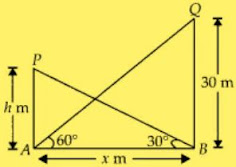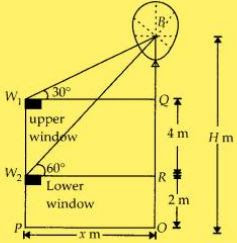Chapter 8 Introduction to Trigonometry and its Equation NCERT Exemplar Solutions Exercise 8.4 Class 10 Maths

Chapter Name | NCERT Maths Exemplar Solutions for Chapter 8 Introduction to Trigonometry and its Equation Exercise 8.4 |
Book Name | NCERT Exemplar for Class 10 Maths |
Other Exercises |
|
Related Study | NCERT Solutions for Class 10 Maths |
Exercise 8.4 Solutions
Long Answer Questions
1. If cosecθ + cotθ = p, then prove that cosθ = (p2 – 1)/(p2 + 1) .
Solution
As,
cosecθ + cot θ = p
2. Prove that √(sec2 θ + cosec2 θ) = tan θ + cot θ.
Solution
Taking,
L.H.S = √(sec2 θ + cosec2 θ)
Since,
3. The angle of elevation of the top of a tower from certain point is 30°. If the observer moves 20 metres towards the tower, the angle of elevation of the top increases by 15°. Find the height of the tower.
Solution
Let us take PR = h meter, the height of the tower.
The distance between the observer and tower is QR = (20 +x) m,
where
QR = QS + SR
= 20 + x
∠PQR = 30°
∠ PSR = θ
In ∆PQR,
tan 30° = h/(20 +x )
⇒ 1/√3 = h/(20 + x)
On cross multiplication,
We get,
20 + x = √3h
⇒ x = √3h - 20 ...eq. (i)
In ∆PSR,
tan θ = h/x
As, angle of elevation increases by 15° when the observer moves 20 m towards the tower.
So,
θ = 30° + 15° = 45°
Therefore,
tan 45° = h/x
⇒ 1 = h/x
⇒ h = x
Putting x = h in eq. (i),
h = √3h - 20
⇒ √3h - h = 20
⇒ h(√3 - 1) = 20
On rationalizing we get,
h = 10(√3 + 1)
The required height of the tower is 10(√3 + 1) meter.
4. If 1 + sin2 θ = 3sin θ cosθ, then prove that tan θ = 1 or 1/2.
Solution
We have,
1 + sin2 θ = 3sin θ cosθ
on dividing L.H.S and R.H.S equations with sin2 θ,
We get,
cosec2 θ + 1 = 3 cot θ
Also,
cosec2 θ - cot2 θ = 1
⇒ cosec2 θ = cot2 θ +1
⇒ cot2 θ +1+1 = 3 cot θ
⇒ cot2 θ +2 = 3 cot θ
⇒ cot2 θ –3 cot θ +2 = 0
We split the middle term and then solve the equation,
cot2 θ – cot θ –2 cot θ +2 = 0
⇒ cot θ(cot θ -1)–2(cot θ +1) = 0
⇒ (cot θ – 1)(cot θ – 2) = 0
⇒ cot θ = 1, 2
We have,
tan θ = 1/cotθ
tan θ = 1, 1/2
Proved !!
5. Given that sinθ + 2cosθ = 1, then prove that 2sinθ - cosθ = 2.
Solution
We have,
sinθ + 2 cosθ = 1
Squaring on both sides,
(sinθ + 2cosθ)2 = 1
⇒ sin2 θ + 4cos2 θ + 4 sinθ cosθ = 1
Also,
sin2 θ = 1 - cos2 θ
and
cos2 θ = 1 - sin2 θ
⇒ (1 - cos2 θ) + 4(1 - sin2 θ) + 4sin θ cosθ = 1
⇒ 1 – cos2 θ + 4 – 4 sin2 θ + 4sin θcos θ = 1
⇒ –4 sin2 θ – cos2 θ + 4sin θcos θ = –4
⇒ 4 sin2 θ + cos2 θ – 4sin θcos θ = 4
Also,
a2 + b2 - 2ab = (a - b)2
So,
(2sin θ – cos θ)2 = 4
⇒ 2sin θ – cos θ = 2
Proved
Let height of the tower be AB = h.

In ABC,
tan θ = AC/BC
= h/s ...(i)
In APC,
tan(90 - θ) = AC/PC
= h/t
cotθ = h/t ...(ii)
So, multiplying (i) and (ii),
tanθ × cot θ = h/t × h/s
⇒ 1 = h2 /st
⇒ h2 = st
⇒ h = √st
Therefore, the height of the tower is √st.

In SRQ,
tan 60° = h/x
⇒ √3 = h/x
⇒ x = h/√3
In SPQ,
tan 30° = h/(50 + x)
1/√3 = h(50 + x)
⇒ 50 + x = √3h
Putting value of x,
50 + h/√3 = √3h
⇒ 50√3 + h = 3h
⇒ 50√3 = 3h - h
⇒ 3h - h = 50√3
⇒ 2h = 50√3
⇒ h = 25√3
So, the required height is 25√3 m.
so that,
FP = h and
FO = H.

tanα = PO/RO
= h/x
x = h/tan α ...(i)
In FRO,
tanβ = FO/RO
⇒ tanβ = (FP + PO)/RO
⇒ tanβ = (H + h)/x
⇒ x = (H+h)/tanβ ...(ii)
From (i) and (ii),
(H + h)/tanβ = h/tanα
On solving,
H = (h tanα)/(tanα + tanβ)
Hence, proved

secθ - tanθ = 1/l ...eq. (ii)
Adding eq. (i) and eq.(ii), we get
(tanθ + secθ) + (secθ - tanθ) = l + 1/l
Adding eq. (i) and eq. (ii), we get
(tanθ + secθ) + (secθ - tanθ) = l + 1/l
So,
secθ = (l2 + 1)/2l .
sinθ + cosθ = p ...(i)
and
secθ + cosecθ = q

Since, sinθ + cosθ = p
On squaring both sides, we get
(sinθ + cosθ)2 = p2
(sin2 θ + cos2 θ) + 2sinθ cosθ = p2
[as, (a + b)2 = a2 + 2ab + b2 ]
1 + 2sinθ cosθ = p2
⇒ 1 + 2(p/q) = p2
⇒ q + 2p = p2q
⇒ 2p = p2q - q
⇒ q(p2 - 1) = 2p
a sinθ + b cosθ = c
On squaring both sides,
(a + sinθ + cosθ b)2 = c2
⇒ a2 + b2 - c2 = a2 cos2 θ + b2 sin2 θ - 2absinθ.cosθ
⇒ a2 + b2 - c2 = a2 cos2 θ + b2 sin2 θ - 2absinθ.cosθ
⇒ a2 + b2 - c2 = (acosθ - bsinθ)2
[as, a2 + b2 - 1ab = (a- b)2]
⇒ a cosθ - bsinθ = √(a2 + b2 - c2 )
On multiplying by (sec θ - tanθ) on numerator and denominator,


Now, in ΔQAB,
tan 60 = QB/AB = 30/x
⇒ √3 = 30/x
⇒ x = 30/√3
⇒ x = 10√3
In PBA,
tan 30 = PA/AB
1/√3 = h/x
⇒ 1/√3 = h/10√3
⇒ h = 10

tan β = AD/CD
⇒ tanβ = h/y
⇒ y = h/tanβ ...(i)
In ABD,
tanα = AD/BD
⇒ tanα = AD/(BC + CD)
⇒ tanα = h/(x + y)
⇒ y = (h/tanα) - x ...(ii)
From (i) and (ii),
(h/tanα) - x = h/tanβ
⇒ x = (h/tanα) - (h/tanβ)
⇒ x = h(cotα - cotβ)
Which is the required distance between the two objects.
OQ = x and
BQ = q,
SA = P
and

cos α = OA/AB
⇒ cos α = y/AB
⇒ y = AB cos α = OA ...(i)
also,
sinα = OB/AB
⇒ OB = AB sinα
In QSO,
cos β = OS/SQ
⇒ OS = SQ cos β = AB cos β
and,
sin β = OQ/SQ
⇒ OQ = SQ sin β = AB sinβ
SA = OS - AO
P = Ab(cos β - cos α )
Also,
BQ = BO - QO
So,
p/q = (cosβ - cos α)/(sin α - sinβ)
OT = H m

Now, in ΔTPO,
tan 60° = OT/OP
⇒ tan 60° = H/x
⇒ x = h/√3
In TAB,
tan 45° = TB/AB
⇒ x = H - 10
Putting value of x,
h/√3 = H - 10
On solving,
H = 5(√3 + 3)m
tan β = WB/OB
⇒ tan β = h/x
⇒ x = h/tanβ ...(i)
In QWM,
tan α = QM/WM
From (i) and (ii),
(H - h)/tanα = h/tan β
On solving,
H = h(1 + tanα × 1/tanβ)

and
OP = W2 R
= W2 Q
= x m
= 2m = OR
Height of upper window from the lower window = W1 W2
= 4m = QR

In BW2 R,
tan 60° = BR/W2 R
= (BQ + QR)/x
⇒ √3 = [(H - 6) + 4]/x
⇒ x = (H - 2)/√3 ...(i)
In BW1 R,
tan 30° = BR/W1 R
⇒ 1/√3 = (H - 6)/x
⇒ x = √3(H - 6) ...(ii)
From (i) and (ii),
√3(H - 6) = (H - 2)/√3
On solving,
H = 8m
The required height is 8m.
Therefore, the required height of the balloon from the ground is 8m.




